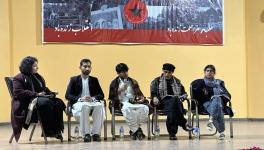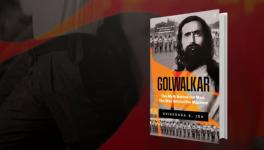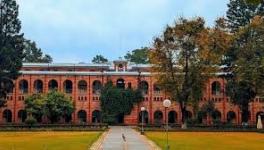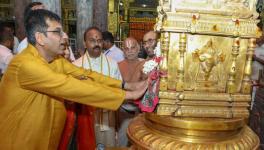In My Own Voice: Heroes, Neros and Zeroes

Image Coutesy: Wikimedia Commons
Eminent journalist and human rights activist Kuldip Nayar passed away on August 23, 2018, but he left behind a manuscript which has just been published. The invite to the launch of the book was tantalisingly titled, ‘From Jinnah to Modi’ and I could not wait to get my hands on it, wondering if Nayar, who had witnessed the bloodbath of Partition and spent his life working for the ideals of secularism, had actually compared Narendra Modi with Muhammad Ali Jinnah.
We all know Jinnah finally succeeded in becoming Qaid – e- Azam and creating Pakistan, but not without the horror of Partition that displaced 10 million people, killed another million and in which innumerable girls were raped and abducted.
When I finally did get the book, I found it was actually titled, ‘On Leaders and Icons from Jinnah to Modi’ and was a commentary on the various personalities Nayar had met -- Gandhi, Jinnah, Shastri et al.
The book is readable because Nayar writes as if he is talking to you and gives you vignettes of his personal experiences, which is of a man who witnessed the birth and development of three countries – India, Pakistan and Bangladesh.
In the preface, Nayar confesses that ‘left to himself he would like to title the book, Heroes, Neros and Zeroes – the heroes being the nameless people of the freedom struggle who even sacrificed their lives, the Neros are the fence-sitters who he calls ‘calculating patriots’ afraid to jump lest they got burnt by the flames of the struggle, and the zeros are those who never participated in the freedom struggle but got the benefits of independence.
A lot could be said about the times today and the Neros and Zeros now, but I will stick to Nayar and his perceptions. Nayar writes that he was privy to the recollections of those who had seen Bhagat Singh, Sukhdev and Rajguru run past them, jump onto their bicycles and disappear into the crowd. When Bhagat Singh and his comrades were hanged, the people wore black bands and refused to listen to Gandhi when he began his speech. It was Jawaharlal Nehru who pacified the young crowd by telling them that for Gandhi non-violence was a creed.
Nayar writes that his mind goes back to the Quit India Movement of 1942 when almost three million people had died due to the British-created famine – we now know that food had been diverted to feed the soldiers of the World War and Churchill had a ‘burn boats’ policy as he feared the Japanese were to invade through Bengal. Nayar recalls the clientele of Firpos restaurant who wined and dined luxuriously while people starved outside, but not a stone was thrown at the glass windows.
Is this fear of the police or non-violence, asks Nayar. But he does not answer the question. He just tells us that they were so different from the French who stormed the barricades on Marie Antoinette’s infamous ‘let them eat cake’, comment. However, I do wish Nayar had addressed this issue frontally as a champion of human rights and as we witness an onslaught on democratic rights, freedom of press and the idea of India, like never before.
Nayar had engaged extensively with the Narmada Bachao Andolan, which is a movement against the displacement of people by the dam and it has remained consistently non-violent despite police brutality. This, I believe, is due to its leadership, as Medha Patkar carries the baton of satyagraha forward along with many nameless ‘heroes’ of the movement.
The chapter on Gandhi is heartfelt. Nayar goes to his prayer meetings and when a Punjabi Hindu objects to the reading of the Quran, Gandhi refuses to hold any further meetings till the man withdraws his objection. A far cry from what is happening today!
What is of deep interest is that Nayar is present when a bomb explodes next to Gandhi – placed by Madan Lal, a Hindu fanatic – but Gandhi does not even look up. Nayar thinks it is a firecracker and learns later that it was a bomb. We all know the tragedy that befell the nation and when the light went out of our lives as Nathuram Godse shot and killed Gandhi on January 30, 1948. Nayar rushes there and gives a deeply felt account of the aftermath. He writes, ‘I never imagined that any Indian would think of Godse as anything but the assassin of the father of the nation. But I was mistaken. Justice Achru Ram Sehgal, who was on the bench that sentenced the killer to death, told me that some women knitted pullovers for Godse.’
Clearly, the virus of Hindutva was kept alive. It just went into hiding and came out virulently years later, to maim and destroy the fabric of society. Nayar writes ‘with the passage of time Gandhi’s creed of nonviolence has come to be accepted by the world as the only way for nations to sort out their problems with their neighbours’. How I wish after Pulwama and Balakot, I could ask Nayar if this is being visualised right now?
Nayar also writes that whenever there is tension between Hindus and Muslims, Gandhi’s martyrdom is recalled, but are these tensions not being stoked, indeed fanned today?
He writes, “he (Gandhi) still guides us decades later with the help of his thoughts enshrined in the Constitution” but the recent resolution by the RSS states that the Constitution cannot be the only determinant and that Hindu sentiments have to be respected vis-a-vis the Sabarimala temple case where they have denied women entry despite a Supreme Court judgement in their favour. This is the Hindu Right-wing’s stand regarding the construction of the Ram temple as well.
On Jinnah, Nayar actually asked him two questions as a student: one, after the formation of Pakistan would not the Hindus and Muslims be at each other’s throat? Jinnah replied, ‘we will be the best of friends. Germany and France fought wars for hundreds of years but now they have good relations.’ The second was, ‘what would be Pakistan’s reaction if a third party were to attack India? And Jinnah replied, ‘blood is thicker than water.’
We can see for ourselves where we are today. He also recounts that initially Jinnah felt that a separate homeland was not the solution but the fear that the end of British Raj was going to end into a Hindu Rashtra was what led to the 1940 two-nation theory and Jinnah’s endorsement of it. Do we take a lesson from this?
I am now going to Nayar’s last chapter on Modi where he acknowledges that “we (Modi and he) are on the same page as opposing the Emergency” but then he writes, “what we differ is in the kind of society we want. He belongs to the BJP, a political organ of the RSS which wants to establish a Hindu Rashtra in the country; whereas I believe in a pluralistic society. His party divides people and I believe in what Mahatma Gandhi taught us about a multi-cultural nation where people of all religions can live without fear.”
Later Nayar writes, “Prime Minister Modi respects Gandhi and says ‘sab ka saath, sab ka vikas’. But his party’s goal is to the contrary.”
Nayar writes, “A diluted form of Hindutva has spread throughout the whole country.” And later, “The Prime Minister has to ask himself whether this scenario is good for the people.” Also, “I find the minorities feeling insecure. They constitute one fourth of the nation”.
You do not need to read between the lines to realise that Nayar is issuing a warning to all of us. What lies ahead is a battle for India’s soul. Will we remain true to the ideals of our founding fathers and the tenets of the Constitution or are we going to become a Hindu Pakistan?
I think in the last chapter Nayar has clearly stated his apprehension about the idea of India being dismantled. The question is with arrest of so many activists, 77 lynchings across the country – including that of a most tragic lynching of a 13-year-old boy, Junaid on a train – whose mother I met recently and I confess, I wept when she showed me a picture of her boy lying in the railway station in a pool of blood -- we are in a state of an undeclared Emergency.
When the consciousness of the people changes there is really something to worry about. The question really is: are we ready to speak up to keep that idea of India or are we going to become another Hindu Pakistan? Are we going to be Neros, Zeros or will be heroes?
Kuldip Nayar had a passion for Urdu poetry – he has a chapter on Faiz Ahmed Faiz - it would not be inappropriate to quote the progressive Pakistani poet, Fahmida Riaz:
‘Tum bilkul hum jaise nikle
Ab tak kahan chhupe the bhai
Voh murkhta, voh ghamarpan
Jis mein hum ne sadi gavai
Aakhri pahuunchi dwaar tumhaari
Are badhai bahut badai’.
Roughly translated :
‘You too are emerging just like us
Where were you hiding all this while brother,
The same stupidity and arrogance
Within which we lost an era
Now it has finally reached your doorstep,
Congratulations! Many congratulations!’
The Pakistani poet warns that the rise of Hindutva is similar to the rise of Islamic fundamentalism in Pakistan.
And then the BJP awards the Padma Bhushan to Kuldip Nayar posthumously, perhaps purely for electoral gains, for, as Nayar writes, “we differ on the society we want.”
Sagari Chhabra Is an award-winning author & a multiple award-winning film-director. The Views are personal.
Get the latest reports & analysis with people's perspective on Protests, movements & deep analytical videos, discussions of the current affairs in your Telegram app. Subscribe to NewsClick's Telegram channel & get Real-Time updates on stories, as they get published on our website.
























